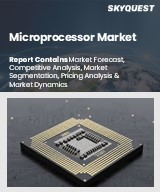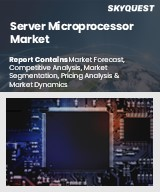
|
시장보고서
상품코드
1530818
세계의 마이크로프로세서 시장 예측(-2030년) : 유형별, 아키텍처별, 기술별, 용도별, 최종 사용자별, 지역별 분석Microprocessors Market Forecasts to 2030 - Global Analysis By Type, Architecture, Technology, Application, End User and By Geography |
||||||
Stratistics MRC에 따르면 세계 마이크로프로세서 시장은 2024년 1,032억 1,000만 달러로 예측 기간 동안 7.7%의 연평균 복합 성장률(CAGR)로 성장하여 2030년까지는 1,385억 9,000만 달러에 이를 것으로 예측됩니다.
마이크로프로세서는 컴퓨터의 중앙 연산 처리 장치(CPU) 역할을 하는 소형 집적 회로입니다. 프로그램으로부터의 명령을 실행해, 산술 연산, 논리 연산, 제어, 입출력(I/O) 조작을 실시합니다. 마이크로프로세서는 CPU의 기능을 하나의 칩에 집적하고 처리 능력과 효율성을 크게 향상시켜 컴퓨팅에 혁명을 가져왔습니다. 복잡한 계산이 가능하며 다양한 분야에서 수많은 용도을 지원합니다.
세계지식재산기구(WIPO)에 따르면 모바일 산업은 기술 도입이 7.6% 증가했으며, 로봇과 자동화는 10.4% 성장했으며, 전기차는 2020년부터 2021년에 걸쳐 61.1%라는 대폭적인 성장을 이뤘다. 했습니다.
시장 역학:
촉진요인:
소비자 일렉트로닉스 확대
스마트폰, 태블릿 단말기, 스마트 TV, 웨어러블 단말기 등 소비자 일렉트로닉스에 대한 수요 증가는 고급 처리 능력의 필요성을 뒷받침하고 있습니다. 이러한 장비가 정교 해짐에 따라 복잡한 작업을 처리하고 사용자 경험을 향상시키고 새로운 기능을 지원하는 강력한 마이크로프로세서가 필요합니다. 이러한 수요 증가는 마이크로프로세서 업계의 혁신과 생산을 자극하고 기술과 효율성의 발전으로 이어집니다. 그 결과 소비자 일렉트로닉스 부문의 확대는 마이크로프로세서에 대한 지속적인 성장과 투자의 원동력이 되고 있습니다.
억제요인:
복잡한 제조 공정
마이크로프로세서는 복잡한 설계와 고급 반도체 제조 기술의 필요성 때문에 제조 공정이 복잡합니다. 이러한 공정에서는 정밀한 포토리소그래피, 에칭, 도핑이 이루어져 수백만 개의 트랜지스터를 가진 마이크로프로세서 칩이 만들어집니다. 이 복잡성은 하이테크 장비, 특수 재료 및 클린 룸 환경을 필요로 하며, 많은 비용과 제조 비용이 길고 개발 사이클이 길어집니다. 이러한 복잡성은 소비자 비용을 증가시키고 공급망 취약성을 조장함으로써 시장 성장을 방해할 수 있습니다.
기회:
5G 네트워크 배포
5G 네트워크 배포는 5G 연결에 필요한 고속, 광대역 및 저지연을 지원할 수 있는 고성능 프로세서에 대한 수요를 높입니다. 이러한 고급 프로세서는 스마트폰, IoT 장비, 네트워크 인프라 등 5G 지원 장비의 복잡한 데이터 처리 요구를 지원하는 데 필수적입니다. 5G 기술이 혁신과 새로운 용도을 추진함에 따라 고급 마이크로프로세서에 대한 수요가 증가하여 시장 성장과 추가 기술 발전으로 이어질 것입니다.
위협:
높은 개발 비용
마이크로프로세서는 고급 설계에 필요한 광범위한 R&D, 정밀 제조 및 최첨단 제조 기술의 필요성 때문에 개발 비용이 높습니다. 마이크로프로세서 설계 및 제조에는 반도체 리소그래피 및 테스트와 같은 고급 프로세스가 필요하며 자본 집약적입니다. 결과적으로, 개발의 경제적 부담은 기술 혁신을 제한하고 마이크로프로세서 제품의 확대를 지연시킴으로써 시장 개척을 방해할 수 있습니다.
COVID-19의 영향
COVID-19의 유행은 마이크로프로세서 시장에 큰 영향을 주었으며 공급망 혼란, 가전제품 수요 증가, 원격 근무 및 학습 급증을 일으켰습니다. 이것은 세계의 반도체 부족을 초래하고 가격을 밀어 올리고 리드 타임을 연장 시켰습니다. 기업은 디지털 전환을 가속화하고 데이터센터, 노트북, 게임기기의 마이크로프로세서 수요를 끌어올리는 한편, 자동차와 산업부문은 칩 부족으로 인한 심각한 생산 지연에 직면했습니다.
예측 기간 동안 ARM 마이크로프로세서 부문이 최대가 될 것으로 예상됩니다.
ARM 마이크로프로세서 부문은 유리한 성장을 이룰 것으로 추정됩니다. ARM 마이크로프로세서는 전력 효율과 다용도로 유명하며 모바일 장치, 임베디드 시스템, IoT 용도에 널리 사용됩니다. ARM Holdings가 설계한 이 프로세서는 RISC 아키텍처를 채택하여 저전력 소비로 고성능을 제공합니다. ARM의 라이선싱 모델을 통해 다양한 제조업체가 ARM 설계를 기반으로 맞춤형 프로세서를 개발할 수 있으므로 다양한 전자 장비에 널리 채택되었습니다.
예측 기간 동안 소비자 일렉트로닉스 부문의 CAGR이 가장 높을 것으로 예상됩니다.
소비자 일렉트로닉스 분야는 예측 기간 동안 가장 높은 CAGR 성장이 예상됩니다. 소비자 전자 제품에 장착된 마이크로프로세서는 장비의 기능과 성능을 향상시키는 데 매우 중요합니다. 마이크로프로세서는 용도 실행, 데이터 처리, 사용자 인터페이스 처리 등의 작업을 관리합니다. 고급 마이크로프로세서는 고해상도 디스플레이, 실시간 처리, 연결 옵션 등의 기능을 가능하게 합니다. 이러한 통합은 더욱 강력하고 효율적이며 다목적 가전제품을 제공하고 혁신을 촉진하며 다양한 장치에서 사용자 경험을 향상시킵니다.
최대 점유율을 차지하는 지역:
아시아태평양의 마이크로프로세서 시장은 급속한 기술 진보, 스마트폰의 보급 확대, 데이터센터의 확장으로 촉진되어 역동적인 성장을 이루고 있습니다. Taiwan Semiconductor Manufacturing Company(TSMC)와 Samsung 등 주요 기업들이 이 지역을 지배하고 있으며, 강력한 제조능력과 기술 혁신의 혜택을 누리고 있습니다. 이 지역의 소비자 일렉트로닉스 시장은 활기차고 있으며, AI, IoT, 5G 기술에 대한 많은 투자도 수요를 더욱 끌어올리고 있습니다. 게다가 반도체 제조 능력을 강화하기 위한 정부의 지원 정책과 이니셔티브는 세계의 마이크로프로세서 시장에서 이 지역의 주도적 지위에 기여하고 있습니다.
CAGR이 가장 높은 지역:
북미의 마이크로프로세서 시장은 첨단 기술 인프라와 AI, 클라우드 컴퓨팅, 5G에 대한 대규모 투자에 의한 왕성한 수요가 특징입니다. 인텔, AMD, 퀄컴 등 대기업이 시장을 선도하고 있으며, 지속적인 혁신과 R&D 노력의 혜택을 누리고 있습니다. 이 지역의 견조한 소비자 일렉트로닉스와 자동차 산업은 마이크로프로세서 수요를 더욱 촉진하고 있습니다. 또한 IoT 디바이스와 에지 컴퓨팅의 채택이 증가하고 있는 것도 시장 성장에 기여하고 있습니다. 국내 반도체 제조를 촉진하고 공급망의 혼란을 완화하기 위한 정부의 이니셔티브는 세계의 마이크로프로세서 시장에서 북미의 경쟁력을 높이고 있습니다.
무료 사용자 정의 서비스:
이 보고서를 구독하는 고객은 다음 무료 맞춤설정 옵션 중 하나를 사용할 수 있습니다.
- 기업 프로파일
- 추가 시장 기업의 종합적 프로파일링(3개사까지)
- 주요 기업의 SWOT 분석(3개사까지)
- 지역 세분화
- 고객의 관심에 응한 주요국 시장 추계·예측·CAGR(주: 타당성 확인에 따름)
- 경쟁 벤치마킹
- 제품 포트폴리오, 지리적 존재, 전략적 제휴에 기반한 주요 기업 벤치마킹
목차
제1장 주요 요약
제2장 서문
- 개요
- 이해관계자
- 조사 범위
- 조사 방법
- 데이터 마이닝
- 데이터 분석
- 데이터 검증
- 조사 접근
- 조사 정보원
- 1차 조사 정보원
- 2차 조사 정보원
- 전제조건
제3장 시장 동향 분석
- 성장 촉진요인
- 억제요인
- 기회
- 위협
- 기술 분석
- 용도 분석
- 최종 사용자 분석
- 신흥 시장
- COVID-19의 영향
제4장 Porter's Five Forces 분석
- 공급기업의 협상력
- 구매자의 협상력
- 대체품의 위협
- 신규 참가업체의 위협
- 경쟁 기업간 경쟁 관계
제5장 세계의 마이크로프로세서 시장 : 유형별
- x86 마이크로프로세서
- ARM 마이크로프로세서
- SPARC 마이크로프로세서
- PowerPC 마이크로프로세서
- MIPS 마이크로프로세서
- 기타 유형
제6장 세계의 마이크로프로세서 시장 : 아키텍처별
- 32비트 마이크로프로세서
- 64비트 마이크로프로세서
제7장 세계의 마이크로프로세서 시장 : 기술별
- 축소 명령 세트 컴퓨팅(RISC)
- 복합 명령 세트 컴퓨팅(CISC)
- 특정 용도용 집적 회로(ASIC)
- 필드 프로그래머블 게이트 어레이(FPGA)
- 기타 기술
제8장 세계의 마이크로프로세서 시장 : 용도별
- 소비자 일렉트로닉스
- 자동차
- 산업
- 헬스케어
- 통신
- 항공우주 및 방위
- 기타 용도
제9장 세계 마이크로프로세서 시장 : 최종 사용자별
- OEM
- 오리지널 디자인 제조업체(ODM)
- 계약 전자기기 제조업자(CEM)
- 애프터마켓
제10장 세계 마이크로프로세서 시장 : 지역별
- 북미
- 미국
- 캐나다
- 멕시코
- 유럽
- 독일
- 영국
- 이탈리아
- 프랑스
- 스페인
- 기타 유럽
- 아시아태평양
- 일본
- 중국
- 인도
- 호주
- 뉴질랜드
- 한국
- 기타 아시아태평양
- 남미
- 아르헨티나
- 브라질
- 칠레
- 기타 남미
- 중동 및 아프리카
- 사우디아라비아
- 아랍에미리트(UAE)
- 카타르
- 남아프리카
- 기타 중동 및 아프리카
제11장 주요 발전
- 계약/파트너십/협업/합작투자(JV)
- 인수와 합병
- 신제품 발매
- 사업 확대
- 기타 주요 전략
제12장 기업 프로파일링
- Intel Corporation
- Advanced Micro Devices(AMD)
- NVIDIA Corporation
- Qualcomm Incorporated
- Apple Inc.
- Samsung Electronics
- Broadcom Inc.
- MediaTek Inc.
- Texas Instruments Incorporated
- IBM Corporation
- STMicroelectronics
- Marvell Technology Group Limited
- Microchip Technology Inc.
- Renesas Electronics Corporation
- NXP Semiconductors NV
- Mindgrove Technologies
- ARM Holdings
According to Stratistics MRC, the Global Microprocessors Market is accounted for $103.21 billion in 2024 and is expected to reach $138.59 billion by 2030 growing at a CAGR of 7.7% during the forecast period. Microprocessors are compact, integrated circuits that serve as the central processing unit (CPU) of a computer. They execute instructions from programs, performing arithmetic, logic, control, and input/output (I/O) operations. Microprocessors revolutionized computing by integrating the functions of a CPU onto a single chip, significantly enhancing processing power and efficiency. It enables complex computations and supports numerous applications in diverse fields.
According to the World Intellectual Property Organization (WIPO), the mobile industry has experienced 7.6% increase in technology adoption, while robots and automation have grown by 10.4%, and electric vehicles have witnessed a significant growth of 61.1% between 2020 and 2021.
Market Dynamics:
Driver:
Growing demand for consumer electronics
The growing demand for consumer electronics, such as smart phones, tablets, smart TVs, and wearables, propels the need for advanced processing capabilities. As these devices become more sophisticated, they require powerful microprocessors to handle complex tasks, enhance user experiences, and support new features. This increased demand stimulates innovation and production in the microprocessor industry, leading to advancements in technology and efficiency. Consequently, the expansion of the consumer electronics sector fuels continued growth and investment in microprocessors.
Restraint:
Complex manufacturing processes
Microprocessors have complex manufacturing processes due to their intricate design and the need for advanced semiconductor fabrication technology. These processes involve precise photolithography, etching, and doping to create microprocessor chips with millions of transistors. The complexity requires high-tech equipment, specialized materials, and clean room environments, leading to substantial production costs and long development cycles. This complexity can hamper market growth by increasing costs for consumers, and contributing to supply chain vulnerabilities.
Opportunity:
Rollout of 5G networks
The rollout of 5G networks raises the demand for high-performance processors that can handle the higher speeds, greater bandwidth, and low latency required for 5G connectivity. These advanced processors are essential for supporting the complex data processing needs of 5G-enabled devices, including smart phones, IoT devices, and network infrastructure. As 5G technology drives innovation and new applications, the demand for sophisticated microprocessors rises, leading to market growth and further technological advancements.
Threat:
High development costs
Microprocessors have high development costs due to the extensive research and development required for advanced designs, precision manufacturing, and the need for cutting-edge fabrication technologies. Designing and producing microprocessors involve sophisticated processes, including semiconductor lithography and testing, which are capital-intensive. Consequently, the financial burden of development can hamper market growth by restricting innovation and slowing the expansion of microprocessor offerings.
Covid-19 Impact
The covid-19 pandemic significantly impacted the microprocessors market, causing supply chain disruptions, increased demand for consumer electronics, and a surge in remote work and learning. This led to a global semiconductor shortage, driving up prices and extending lead times. Companies accelerated digital transformations, boosting demand for microprocessors in data centers, laptops, and gaming devices, while automotive and industrial sectors faced severe production delays due to chip shortages.
The ARM microprocessors segment is expected to be the largest during the forecast period
The ARM microprocessors segment is estimated to have a lucrative growth. ARM microprocessors are renowned for their power efficiency and versatility, making them widely used in mobile devices, embedded systems, and IoT applications. Designed by ARM Holdings, these processors use RISC architecture, enabling high performance with lower power consumption. ARM's licensing model allows various manufacturers to develop custom processors based on ARM's designs, leading to widespread adoption across diverse electronic devices.
The consumer electronics segment is expected to have the highest CAGR during the forecast period
The consumer electronics segment is anticipated to witness the highest CAGR growth during the forecast period. Microprocessors in consumer electronics are crucial for enhancing device functionality and performance. They manage tasks by executing applications, processing data, and handling user interfaces. Advanced microprocessors enable features like high-resolution displays, real-time processing, and connectivity options. Their integration allows for more powerful, efficient, and versatile consumer electronics, driving innovation and improving user experiences across a wide range of devices.
Region with largest share:
The microprocessors market in the Asia Pacific region is experiencing robust growth, driven by rapid technological advancements, increased adoption of smartphones, and expansion of data centers. Key players like Taiwan Semiconductor Manufacturing Company (TSMC) and Samsung dominate the region, benefiting from strong manufacturing capabilities and innovation. The region's booming consumer electronics market, along with significant investments in AI, IoT, and 5G technologies, further propels demand. Additionally, supportive government policies and initiatives aimed at enhancing semiconductor manufacturing capacity contribute to the region's leading position in the global microprocessors market.
Region with highest CAGR:
The North American microprocessors market is characterized by strong demand driven by advanced technological infrastructure and significant investments in AI, cloud computing, and 5G. Major companies like Intel, AMD, and Qualcomm lead the market, benefiting from continuous innovation and R&D efforts. The region's robust consumer electronics and automotive industries further fuel demand for microprocessors. Additionally, the increasing adoption of IoT devices and edge computing contributes to market growth. Government initiatives to boost domestic semiconductor manufacturing and mitigate supply chain disruptions enhance North America's competitive edge in the global microprocessors market.
Key players in the market
Some of the key players profiled in the Microprocessors Market include Intel Corporation, Advanced Micro Devices (AMD), NVIDIA Corporation, Qualcomm Incorporated, Apple Inc., Samsung Electronics, Broadcom Inc., MediaTek Inc., Texas Instruments Incorporated, IBM Corporation, STMicroelectronics, Marvell Technology Group Limited, Microchip Technology Inc., Renesas Electronics Corporation, NXP Semiconductors N.V., Mindgrove Technologies and ARM Holdings.
Key Developments:
In May 2024, Mindgrove Technologies launched first indigenously designed microcontroller chip. This chip, based on the RISC-V architecture, represents a noteworthy achievement in the company's development capabilities and signals a move towards greater self-reliance in microprocessor design.
In May 2023, STMicroelectronics has introduced the second generation of its STM32 MPUs (microprocessors), with a new architecture built upon the same ecosystem and raising performance and security for applications at the industrial and IoT edge. With support for 32-bit DDR4 and LPDDR4 memories, the STM32MP25 ensures long-term support for cost-optimized designs.
Types Covered:
- x86 Microprocessors
- ARM Microprocessors
- SPARC Microprocessors
- PowerPC Microprocessors
- MIPS Microprocessors
- Other Types
Architectures Covered:
- 32-bit Microprocessors
- 64-bit Microprocessors
Technologies Covered:
- Reduced Instruction Set Computing (RISC)
- Complex Instruction Set Computing (CISC)
- Application-Specific Integrated Circuit (ASIC)
- Field-Programmable Gate Array (FPGA)
- Other Technologies
Applications Covered:
- Consumer Electronics
- Automotive
- Industrial
- Healthcare
- Telecommunications
- Aerospace & Defense
- Other Applications
End Users Covered:
- Original Equipment Manufacturers (OEMs)
- Original Design Manufacturers (ODMs)
- Contract Electronics Manufacturers (CEMs)
- Aftermarket
Regions Covered:
- North America
- US
- Canada
- Mexico
- Europe
- Germany
- UK
- Italy
- France
- Spain
- Rest of Europe
- Asia Pacific
- Japan
- China
- India
- Australia
- New Zealand
- South Korea
- Rest of Asia Pacific
- South America
- Argentina
- Brazil
- Chile
- Rest of South America
- Middle East & Africa
- Saudi Arabia
- UAE
- Qatar
- South Africa
- Rest of Middle East & Africa
What our report offers:
- Market share assessments for the regional and country-level segments
- Strategic recommendations for the new entrants
- Covers Market data for the years 2022, 2023, 2024, 2026, and 2030
- Market Trends (Drivers, Constraints, Opportunities, Threats, Challenges, Investment Opportunities, and recommendations)
- Strategic recommendations in key business segments based on the market estimations
- Competitive landscaping mapping the key common trends
- Company profiling with detailed strategies, financials, and recent developments
- Supply chain trends mapping the latest technological advancements
Free Customization Offerings:
All the customers of this report will be entitled to receive one of the following free customization options:
- Company Profiling
- Comprehensive profiling of additional market players (up to 3)
- SWOT Analysis of key players (up to 3)
- Regional Segmentation
- Market estimations, Forecasts and CAGR of any prominent country as per the client's interest (Note: Depends on feasibility check)
- Competitive Benchmarking
- Benchmarking of key players based on product portfolio, geographical presence, and strategic alliances
Table of Contents
1 Executive Summary
2 Preface
- 2.1 Abstract
- 2.2 Stake Holders
- 2.3 Research Scope
- 2.4 Research Methodology
- 2.4.1 Data Mining
- 2.4.2 Data Analysis
- 2.4.3 Data Validation
- 2.4.4 Research Approach
- 2.5 Research Sources
- 2.5.1 Primary Research Sources
- 2.5.2 Secondary Research Sources
- 2.5.3 Assumptions
3 Market Trend Analysis
- 3.1 Introduction
- 3.2 Drivers
- 3.3 Restraints
- 3.4 Opportunities
- 3.5 Threats
- 3.6 Technology Analysis
- 3.7 Application Analysis
- 3.8 End User Analysis
- 3.9 Emerging Markets
- 3.10 Impact of Covid-19
4 Porters Five Force Analysis
- 4.1 Bargaining power of suppliers
- 4.2 Bargaining power of buyers
- 4.3 Threat of substitutes
- 4.4 Threat of new entrants
- 4.5 Competitive rivalry
5 Global Microprocessors Market, By Type
- 5.1 Introduction
- 5.2 x86 Microprocessors
- 5.3 ARM Microprocessors
- 5.4 SPARC Microprocessors
- 5.5 PowerPC Microprocessors
- 5.6 MIPS Microprocessors
- 5.7 Other Types
6 Global Microprocessors Market, By Architecture
- 6.1 Introduction
- 6.2 32-bit Microprocessors
- 6.3 64-bit Microprocessors
7 Global Microprocessors Market, By Technology
- 7.1 Introduction
- 7.2 Reduced Instruction Set Computing (RISC)
- 7.3 Complex Instruction Set Computing (CISC)
- 7.4 Application-Specific Integrated Circuit (ASIC)
- 7.5 Field-Programmable Gate Array (FPGA)
- 7.6 Other Technologies
8 Global Microprocessors Market, By Application
- 8.1 Introduction
- 8.2 Consumer Electronics
- 8.3 Automotive
- 8.4 Industrial
- 8.5 Healthcare
- 8.6 Telecommunications
- 8.7 Aerospace & Defense
- 8.8 Other Applications
9 Global Microprocessors Market, By End User
- 9.1 Introduction
- 9.2 Original Equipment Manufacturers (OEMs)
- 9.3 Original Design Manufacturers (ODMs)
- 9.4 Contract Electronics Manufacturers (CEMs)
- 9.5 Aftermarket
10 Global Microprocessors Market, By Geography
- 10.1 Introduction
- 10.2 North America
- 10.2.1 US
- 10.2.2 Canada
- 10.2.3 Mexico
- 10.3 Europe
- 10.3.1 Germany
- 10.3.2 UK
- 10.3.3 Italy
- 10.3.4 France
- 10.3.5 Spain
- 10.3.6 Rest of Europe
- 10.4 Asia Pacific
- 10.4.1 Japan
- 10.4.2 China
- 10.4.3 India
- 10.4.4 Australia
- 10.4.5 New Zealand
- 10.4.6 South Korea
- 10.4.7 Rest of Asia Pacific
- 10.5 South America
- 10.5.1 Argentina
- 10.5.2 Brazil
- 10.5.3 Chile
- 10.5.4 Rest of South America
- 10.6 Middle East & Africa
- 10.6.1 Saudi Arabia
- 10.6.2 UAE
- 10.6.3 Qatar
- 10.6.4 South Africa
- 10.6.5 Rest of Middle East & Africa
11 Key Developments
- 11.1 Agreements, Partnerships, Collaborations and Joint Ventures
- 11.2 Acquisitions & Mergers
- 11.3 New Product Launch
- 11.4 Expansions
- 11.5 Other Key Strategies
12 Company Profiling
- 12.1 Intel Corporation
- 12.2 Advanced Micro Devices (AMD)
- 12.3 NVIDIA Corporation
- 12.4 Qualcomm Incorporated
- 12.5 Apple Inc.
- 12.6 Samsung Electronics
- 12.7 Broadcom Inc.
- 12.8 MediaTek Inc.
- 12.9 Texas Instruments Incorporated
- 12.10 IBM Corporation
- 12.11 STMicroelectronics
- 12.12 Marvell Technology Group Limited
- 12.13 Microchip Technology Inc.
- 12.14 Renesas Electronics Corporation
- 12.15 NXP Semiconductors N.V.
- 12.16 Mindgrove Technologies
- 12.17 ARM Holdings



















